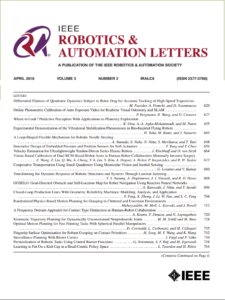![]() Lars Kunze, Nick Hawes, Tom Duckett, and Marc Hanheide
Lars Kunze, Nick Hawes, Tom Duckett, and Marc Hanheide
Introduction to the Special Issue on AI for Long-Term Autonomy
IEEE Robotics and Automation Letters (Volume: 3, Issue: 4, 2018)

Abstract
The papers in this special section focus on the use of artificial intelligence (AI) for long term autonomy. Autonomous systems have a long history in the fields of AI and robotics. However, only through recent advances in technology has it been possible to create autonomous systems capable of operating in long-term, real-world scenarios. Examples include autonomous robots that operate outdoors on land, in air, water, and space; and indoors in offices, care homes, and factories. Designing, developing, and maintaining intelligent autonomous systems that operate in real-world environments over long periods of time, i.e. weeks, months, or years, poses many challenges. This special issue focuses on such challenges and on ways to overcome them using methods from AI. Long-term autonomy can be viewed as both a challenge and an opportunity. The challenge of long-term autonomy requires system designers to ensure that an autonomous system can continue operating successfully according to its real-world application demands in unstructured and semi-structured environments. This means addressing issues related to hardware and software robustness (e.g., gluing in screws and profiling for memory leaks), as well as ensuring that all modules and functions of the system can deal with the variation in the environment and tasks that is expected to occur over its operating time.
@article{Kunze2018,
doi = {10.1109/lra.2018.2870466},
url = {https://doi.org/10.1109/lra.2018.2870466},
year = {2018},
month = {oct},
publisher = {Institute of Electrical and Electronics Engineers ({IEEE})},
volume = {3},
number = {4},
pages = {4431--4434},
author = {L. Kunze and N. Hawes and T. Duckett and M. Hanheide},
title = {Introduction to the Special Issue on {AI} for Long-Term Autonomy},
journal = {{IEEE} Robotics and Automation Letters}
}
